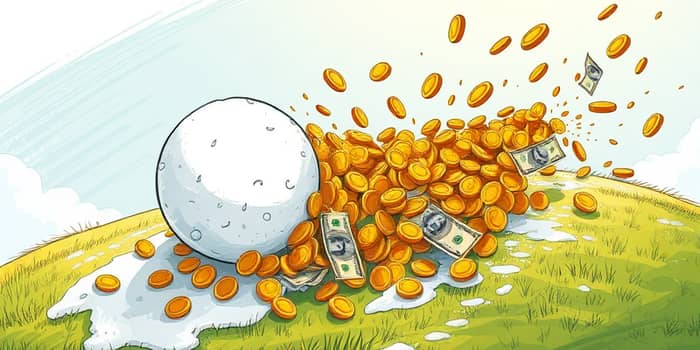Compound interest is one of the most powerful forces in personal finance and wealth building. By earning interest not only on your initial principal but also on the interest that has already been added, your money can grow at an ever-increasing rate. Understanding compound interest can help you make informed choices about saving, investing, and borrowing.
Whether you are planning for retirement, saving for a major purchase, or managing debt, learning the fundamentals of compounding will empower you to accelerate growth over time and harness the potential of your resources.
Understanding Compound Interest
At its core, compound interest is interest on both principal and interest. Unlike simple interest, which is calculated only on the original amount you deposit or borrow, compound interest grows on the cumulative balance in your account.
Imagine planting a seed that not only sprouts into a tree, but also drops new seeds that grow into additional trees year after year. That is the powerful visualization of the snowball effect in action, as each new growth generates further growth.
The Compound Interest Formula
The standard formula to calculate the future value of an investment or loan with compound interest is:
A = P (1 + r/n)^{nt}
Where:
- A = the amount of money accumulated after n periods
- P = the principal or initial amount invested or borrowed
- r = the annual interest rate (decimal form)
- n = the number of times interest is compounded per year
- t = the number of years the money is invested or borrowed for
If you wish to isolate only the interest earned, you can subtract the principal:
Interest = P ( (1 + r/n)^{nt} – 1 )
Illustrating the Snowball Effect
To see compound interest at work, consider a simple example. You deposit $1,000 at a 5% annual rate, compounded once per year:
- End of Year 1: $1,050 ($1,000 × 1.05)
- End of Year 2: $1,102.50 ($1,050 × 1.05)
- End of Year 3: $1,157.63 ($1,102.50 × 1.05)
Notice how the interest earned in Year 2 is based on the new balance of $1,050, not just the original principal. Over time, this dynamic process leads to significant growth over long periods, especially when you reinvest regularly.
Key Factors Influencing Growth
Three main elements determine how quickly compound interest accumulates:
- The more frequently interest is compounded: Daily, monthly, quarterly, or annually. More frequent compounding yields a higher effective rate.
- Interest rate: A higher annual rate accelerates growth and boosts returns on your investment.
- The longer the investment period: Time allows compounding to produce exponential growth, rewarding patience and consistency.
Comparing Simple and Compound Interest
To illustrate the difference, let’s compare $1,000 invested at 5% simple interest versus compound interest over 10 years:
Over a decade, compound interest yields nearly $130 more than simple interest on the same principal and rate. As rates and time horizons grow, the gap widens dramatically.
Practical Applications and Tips
Understanding compound interest can guide many financial decisions. Here are practical ways to leverage its power:
- Retirement planning: Begin contributions early to maximize decades of compounding and build a secure nest egg.
- Debt management: Pay more than the minimum on loans and credit cards to reduce the impact of compounding interest working against you.
- Savings goals: Use high-yield savings or certificates of deposit to take advantage of regular compounding.
- Investment diversification: Combine compound-growth assets like stocks and bonds to balance risk and return.
Tools such as online calculators and spreadsheet models can help you project future balances under various rates, timeframes, and compounding frequencies. Studying these projections empowers you to choose the most advantageous strategies.
Building a Compound Interest Mindset
Beyond formulas and tables, the true value of compound interest comes from adopting a long-term perspective:
1. Start Early: Every year you delay saving costs you potential compounding growth.
2. Reinvest Dividends: Let earnings flow back into your investments automatically.
3. Stay Consistent: Regular contributions, even small ones, can add up over time.
By embracing disciplined saving and investing, you transform your financial future and witness firsthand the principal and previously earned interest join forces to accelerate your wealth.
Conclusion
Compound interest is more than a mathematical concept—it’s a game changer for anyone seeking financial freedom. By understanding how compounding works, leveraging the right accounts, and maintaining a long-term mindset, you can watch your savings blossom into significant wealth.
Whether you are just starting your financial journey or refining an existing portfolio, the fundamentals of compound interest will guide your decisions and inspire you to take action today. Harness this extraordinary force and let time be your greatest ally in building a prosperous future.
References
- https://www.investopedia.com/terms/c/compoundinterest.asp
- https://www.consumerfinance.gov/ask-cfpb/how-does-compound-interest-work-en-1683/
- https://www.securian.com/insights-tools/articles/how-compound-interest-works.html
- https://www.investopedia.com/articles/investing/020614/learn-simple-and-compound-interest.asp
- https://www.td.com/ca/en/personal-banking/advice/growing-money/what-is-compound-interest-and-how-does-it-work
- https://www.thecalculatorsite.com/finance/calculators/compound-interest-formula
- https://study.com/academy/lesson/compounding-interest-formulas-calculations-examples.html
- https://www.equifax.co.uk/resources/loans-and-credit/explaining-compound-interest.html










